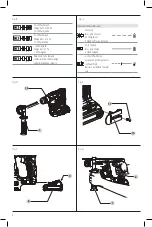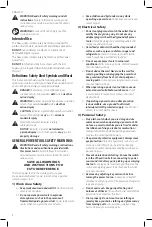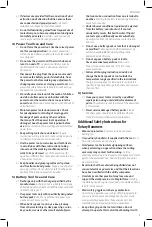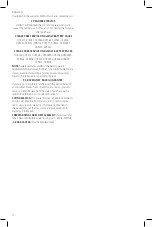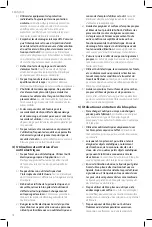
English
10
1. Turn the mode selector
5
to the drill symbol
14
.
2. Use sharp drill bits only. For Wood, use twist bits,
spade bits, power auger bits or hole saws. For Metal,
use high‑speed steel twist drill bits or hole saws. Use a
cutting lubricant when drilling metals. The exceptions
are cast iron and brass which should be drilled dry. For
MASONRY, such as brick, cement, cinder block, etc., use
carbide‑tipped bits rated for percussion drilling.
3. Always apply pressure in a straight line with the bit. Use
enough pressure to keep drill biting, but do not push
hard enough to stall the motor or deflect the bit.
4. Hold tool firmly with both hands to control the twisting
action of the drill. If model is not equipped with side
handle, grip drill with one hand on the handle and one
hand on the battery pack.
WARNING:
Drill may stall if overloaded causing a
sudden twist. Always expect the stall. Grip the drill
firmly to control the twisting action and avoid injury.
5. IF DRILL STALLS, it is usually because it is being
overloaded or improperly used. RELEASE TRIGGER
IMMEDIATELY, remove drill bit from work, and determine
cause of stalling. DO NOT depress TRIGGER ON AND OFF
IN AN ATTEMPT TO START A STALLED DRILL — THIS CAN
DAMAGE THE DRILL.
6. To minimize stalling or breaking through the material,
reduce pressure on drill and ease the bit through the last
fractional part of the hole.
7. Keep the motor running when pulling the bit back out of
a drilled hole. This will help prevent jamming.
8. With variable speed drills there is no need to center
punch the point to be drilled. Use a slow speed to start
the hole and accelerate by squeezing the trigger harder
when the hole is deep enough to drill without the bit
skipping out.
Drilling in Metal
An SDS plus
®
to round shank adaptor chuck is required.
Ensure that tool is in drill‑only mode. Start drilling with slow
speed and increase to full power while applying firm pressure
on the tool. A smooth even flow of metal chips indicates
the proper drilling rate. Use a cutting lubricant when drilling
metals. The exceptions are cast iron and brass which should
be drilled dry.
nOTE:
Large (5/16" to 1/2" [7.9 mm to 12.7 mm]) holes in
steel can be made easier if a pilot hole (5/32" to 3/16" [4 mm
to 4.8 mm]) is drilled first.
Drilling in Wood
An SDS plus
®
to round shank adaptor chuck is required.
Ensure that tool is in drill‑only mode. Start drilling with slow
speed and increase to full power while applying firm pressure
on the tool. Holes in wood can be made with the same twist
drills used for metal. These bits may overheat unless pulled
out frequently to clear chips from the flutes. For larger holes,
use spade bits, power auger bits, or hole saws. Work that is
apt to splinter should be backed up with a block of wood.
Drilling (Fig. I)
WARNING:
To reduce the risk of personal injury,
ALWAYS
operate the tool with the side handle properly
installed. Failure to do so may result in the side handle
slipping during tool operation and subsequent loss of
control. Hold tool with both hands to maximize control.
NOTICE:
If drilling thin material, use a wood “back‑up”
block to prevent damage to the material.
SDS plus® Chuck (Fig. J)
WARNING:
Burn Hazard.
ALWAYS
wear gloves when
changing bits. Accessible metal parts on the tool and
bits may get extremely hot during operation. Small bits
of broken material may damage bare hands.
To insert bit, insert shank of bit about 3/4" (19 mm) into
chuck
12
. Push and rotate bit until it locks in place. The bit
will be securely held.
To release bit, pull the sleeve
13
back and remove the bit.
Electronic Overload Protection
If the drill bit becomes jammed, the power to the drill
spindle will be interrupted by the activation of the electronic
overload protection. To reactivate the power to the drive
spindle, the tool's trigger should be released and then
depressed. Due to the resulting forces, always hold the tool
with both hands and take a firm stance.
Mode Selector Knob (Fig. I)
CAUTION:
Do not change to drill or hammerdrill
mode with a chisel bit in the chuck. Personal injury and
damage to tool may result.
CAUTION:
Never change the mode while the unit
is running.
For drilling (non‑percussion) rotate the mode selector
knob
5
in the down position until the line aligns with
the drill bit symbol
14
. For rotary hammer drilling (with
percussion) rotate the mode selector knob in the up position
until the line aligns to the drill bit and hammer symbol
15
.
nOTE:
The mode selector knob must be in drill or
hammer mode at all times. There are no operable positions
in between.
Worklight (Fig. A)
CAUTION: Do not stare into worklight.
Serious eye
injury could result.
There is a worklight
7
located on the front of the tool. The
worklight is activated when the trigger switch is depressed,
and will automatically turn off 20 seconds after the trigger
switch is released. If the trigger switch remains depressed,
the worklight will remain on.
nOTE:
The worklight is for lighting the immediate work
surface and is not intended to be used as a flashlight.
The center position of the control button locks the tool
in the off position.
When changing the position of the
control button, be sure the trigger is released.
nOTE:
The first time the tool is run after changing the
direction of rotation, you may hear a click on start up. This is
normal and does not indicate a problem.




